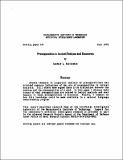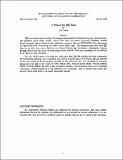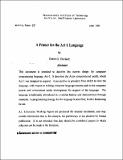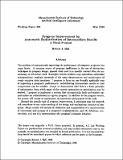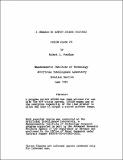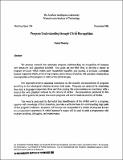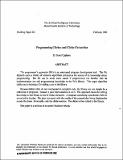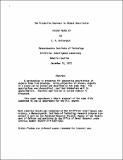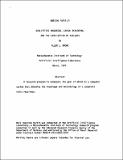Browsing AI Working Papers (1971 - 1995) by Title
Now showing items 182-201 of 291
-
Presupposition in Lexical Analysis and Discourse
(MIT Artificial Intelligence Laboratory, 1975-07)Recent research in linguistic analysis of presuppositions has provided numerous indications of the role of presupposition in lexical analysis. Still others have argued there is no distinction between meaning and the ... -
A Primer for TEX Users
(MIT Artificial Intelligence Laboratory, 1982-03)TEX is our latest text formatter. It is designed specifically for technical text (e.g., mathematics), and produces much higher quality output than other formatters previously available. Donald Knuth designed TEX at Stanford ... -
A Primer for the Act-1 Language
(MIT Artificial Intelligence Laboratory, 1981-06)This document is intended to describe the current design for computer programming language, Act-1. It describes the Actor computational model, which Act-1 was designed to support. A perspective is provided from which to ... -
Principles of Knowledge Representation and Reasoning in the FRAPPE System
(MIT Artificial Intelligence Laboratory, 1989-05)The purpose of this paper is to elucidate the following four important architectural principles of knowledge representation and reasoning with the example of an implemented system: limited reasoning, truth maintenance, ... -
A Program Design Assistant
(MIT Artificial Intelligence Laboratory, 1989-06)The DA will be a design assistant which can assist the programmer in low-level design. The input language of the DA is a cliché-based program description language that allows the specification and high-level design of ... -
Program Improvement by Automatic Redistribution of Intermediate Results
(MIT Artificial Intelligence Laboratory, 1988-05)The problem of automatically improving the performance of computer programs has many facets. A common source of program inefficiency is the use of abstraction techniques in program design: general tools used in a specific ... -
A Program to Output Stored Pictures
(MIT Artificial Intelligence Laboratory, 1972-06)A program called LPTSEE has been written for use with the MIT vision system. LPTSEE makes use of the overprint capability of the line printer to allow the user to output a stored picture image. -
Program Understanding through Cliché Recognition
(MIT Artificial Intelligence Laboratory, 1981-12)We propose research into automatic program understanding via recognition of common data structures and algorithms (clichés). Our goals are two-fold: first, to develop a theory of program structure which makes such recognition ... -
Programming Cliches and Cliche Extraction
(MIT Artificial Intelligence Laboratory, 1982-02)The programmer's apprentice (PA) is an automated program development tool. The PA depends upon a library of common algorithms (cliches) as the source of its knowledge about programming. The PA can be made more usable if ... -
Progress in Extending the VIRGIN Program
(MIT Artificial Intelligence Laboratory, 1971-09)The VIRGIN program will interpret pictures of simple scenes. This paper describes a program, SINNER, which will deal with picture which contain cracks and shadows. In addition to handling pictures of this richer world, ... -
The Projective Approach to Object Description
(MIT Artificial Intelligence Laboratory, 1972-12-15)A methodology is presented for generating descriptions of objects from line drawings. Using projection of planes, objects in a scene can be parsed and described at the same time. The descriptions are hierarchical, and lend ... -
Proposal For a Study of Commonsense Physical Reasoning
(MIT Artificial Intelligence Laboratory, 1981-07)Our common sense views of physics are the first coin in our intellectual capital; understanding precisely what they contain could be very important both for understanding ourselves and for making machines more like us. ... -
A Proposal For An Intelligent Debugging Assistant
(MIT Artificial Intelligence Laboratory, 1988-01)There are many ways to find bugs in programs. For example, observed input and output values can be compared to predicted values. An execution trace can be examined to locate errors in control flow. The utility of these and ... -
A Proposal for Research With the Goal of Formulating a Computational Theory of Rational Action
(MIT Artificial Intelligence Laboratory, 1985-04)A theory of rational action can be used to determine the right action to perform in a situation. I will develop a theory of rational action in which an agent has access to an explicit theory of rationality. The agent makes ... -
A Proposal for Sniffer: a System that Understands Bugs
(MIT Artificial Intelligence Laboratory, 1980-07)This paper proposes an interactive debugging aid that exhibits a deep understanding of a narrow class of bugs. This system, called Sniffer, will be able to find and identify errors, and explain them in terms which are ... -
Protection and Synchronization in Actor Systems
(MIT Artificial Intelligence Laboratory, 1974-11)This paper presents a unified method [called ENCASING] for dealing with the closely related issues of synchronization and protection in actor systems [Hewitt et al. 1973a, 1973b, 1974a; Greif and Hewitt 1975]. Actors are ... -
PSUDOC - A Simple Diagnostic Program
(MIT Artificial Intelligence Laboratory, 1976-12)This paper describes PSUDOC, a very simple LISP program to carry out some medical diagnosis tasks. The program's domain is a subset of clinical medicine characterized by patients presenting with edema and/or hematuria. The ... -
Puma/Cougar Implementor's Guide
(MIT Artificial Intelligence Laboratory, 1985-04)This document is intended to be a guide to assist a programmer in modifying or extending the Lisp Puma system, the Puma PDP-11 system, or the Cougar PDP-11 system. It consists mostly of short descriptions or hints, and is ... -
Qualitative Knowledge, Causal Reasoning, and the Localization of Failures
(MIT Artificial Intelligence Laboratory, 1974-03)A research program is proposed, the goal of which is a computer system that embodies the knowledge and methodology of a competent radio repairman. -
Quantitative Aspects of the Computation Performed by Visual Cortex in the Cat, With a Note on a Function of Lateral Inhibition
(MIT Artificial Intelligence Laboratory, 1973-12)A quantitative summary is given of the computation that is performed by visual cortex in the cat. Part of this computation seems to be achieved using a sample-and-average technique; some quantitative features of this ...
